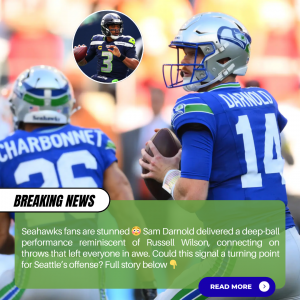Stephen A. Smith Sounds the Alarm: Dallas Cowboys’ Defense Must Step Up or Risk Another Year of Disappointment
Dallas, TX – October 31, 2025
The Dallas Cowboys are at a critical juncture. While their offense has been a league-wide showcase of explosiveness and talent, their defense remains one of the most glaring weaknesses in the NFL. With the trade deadline looming and playoff hopes hanging in the balance, ESPN personality Stephen A. Smith has publicly urged Cowboys owner Jerry Jones to act decisively, emphasizing that without defensive reinforcements, the team risks another season of unfulfilled potential.
A Tale of Two Units
It’s a familiar storyline for Dallas this season: a top-tier offense paired with a struggling defense. On one side of the ball, quarterback Dak Prescott has been a model of efficiency, completing 70.3% of his passes for 2,069 yards and 16 touchdowns through eight games. His QBR of 79.5 leads the league, reflecting a combination of accuracy, timing, and decision-making that has allowed the Cowboys to keep pace in competitive matchups.
Supporting Prescott are star wide receivers CeeDee Lamb and George Pickens, whose early-season performances have electrified fans. Pickens, in particular, has amassed 685 receiving yards and six touchdowns in just eight games, demonstrating the kind of explosive playmaking ability Dallas counted on when pairing him with Lamb. Meanwhile, running back Javonte Williams has emerged as a reliable dual-threat, contributing both on the ground and as a receiving option out of the backfield.
Collectively, the offense ranks first in passing yards per game (263.8) and second in total yards (383.1) and points per game (30.8). For a team that has struggled with offensive consistency in recent seasons, these numbers are a breath of fresh air, and they underscore Prescott’s command of the offense and the effectiveness of the coaching staff’s schemes.
The Defensive Crisis

Unfortunately for Dallas, their defense tells a much different story. The unit ranks 31st in total yards allowed (404.6) and 31st in points allowed (31.3) per game. After the Week 8 44-24 loss to the Denver Broncos, the contrast between the Cowboys’ potent offense and porous defense could not have been starker.
Part of the struggle stems from the absence of former All-Pro linebacker Micah Parsons, who was traded to Green Bay prior to Week 1. Parsons has excelled in the NFC, recording four sacks and six quarterback hits in three October games and earning NFC Defensive Player of the Month, leaving the Cowboys’ front seven to deal with a glaring void. Without him, Dallas has generated just 10 sacks through eight games and has struggled to pressure opposing quarterbacks, leaving their secondary exposed and vulnerable to big plays.
The performance gap has not gone unnoticed. Stephen A. Smith, known for his unfiltered commentary, did not mince words during an interview with 105.3 The Fan, stating:
“I’m just sitting here looking at how explosive this offense is… But if you can’t find a way to get to the quarterback, who the hell knows what could happen?”
Smith’s blunt assessment echoed a sentiment shared by many in Cowboys Nation. The offense, capable of dominating statistically in nearly every facet, has been forced to carry the team while the defense repeatedly fails to hold opponents in critical situations.
Jerry Jones in the Spotlight
The criticism intensified following remarks Jones made to the Wall Street Journal, in which he suggested that he was more focused on outside business opportunities than resolving the Cowboys’ defensive shortcomings:
“There’s $100 billion present value with gas out there… That’s why I’m talking to you on the telephone rather than trying to fix our defense.”
For Smith and others, Jones’ comments were the proverbial spark. On ESPN’s First Take, Smith did not hold back:
“What kind of ignorant statement is that? If the Cowboys miss the playoffs because they didn’t improve a defense that was clearly compromised once Micah Parsons was gone, they’re going to hold onto that quote, Jerry. You couldn’t have kept that to yourself?”
Smith framed the issue not only as a matter of team performance but also as a leadership question. At 83, Jones has the authority and resources to make high-impact moves, yet the team’s defensive struggles have persisted, raising concerns about whether his attention is properly divided.
“Jerry’s my buddy, but the man ain’t getting younger, he’s 83. The clock’s ticking. You can’t be standing pat, talking to the Wall Street Journal about gas deals, while your defense is straight trash,” Smith said.
The spotlight on Jones comes at a delicate time. With the NFL trade deadline approaching, opportunities to improve the roster are limited, but potentially impactful. According to NFL Network reporter Ian Rapoport, defensive stars like Arden Key and Jeffery Simmons of the Tennessee Titans could be available for trade, offering Dallas a chance to shore up the front seven and revitalize a defense that has been a liability through the first half of the season.
Trade Deadline Options and Strategy
The Cowboys face a challenging calculus. Adding a player like Simmons, a three-time Pro Bowler, would likely require significant draft capital or salary cap commitments. Yet the cost of inaction could be higher—wasted offensive production, missed playoff opportunities, and growing fan frustration.
Analysts suggest that Dallas may need to prioritize defensive line depth and pass-rush talent. The absence of Parsons has left gaps that cannot easily be compensated for by rotation players. Defensive coordinator Dan Quinn has implemented a mix of blitz packages and zone coverage to mask weaknesses, but over time, schemes can only do so much against high-powered offenses.
In addition to personnel acquisitions, coaching adjustments may be necessary. The Cowboys have relied heavily on their young secondary and linebacker corps, but with limited pass-rush support, these units have been exposed repeatedly. Smith, speaking for frustrated fans and observers alike, stressed the urgency:
“You’ve got an offense that can win it all. You just need a defense that’s average, not great, just middle of the road. You’ve got to help your offense somehow, someway.”
The message is clear: Dallas cannot rely solely on offensive firepower to carry the team through the postseason. Balance is essential.
Offense: The Bright Spot
While the defensive struggles dominate headlines, it would be remiss to ignore the offensive prowess that has made the Cowboys competitive. Prescott has demonstrated poise and efficiency, distributing the ball effectively and limiting turnovers. His partnership with Lamb and Pickens has created a deep, multi-dimensional passing attack, while Williams provides balance and versatility.
This offensive firepower has kept Dallas within striking distance in most games. Even in losses, the unit has posted significant yardage and scoring output, underscoring the capability of the team when protected by effective line play and supported by skilled playmakers.
Yet Prescott’s efficiency is tied to game context. Much of the offense’s success has come when establishing early leads and playing from ahead, a scenario that reduces the need for high-risk fourth-quarter comebacks. The defense’s inability to slow opponents, however, has forced the offense into stressful situations, increasing the likelihood of mistakes or stalled drives.
Looking Ahead: Must-Win Matchups
The Cowboys face a critical stretch of games beginning with Monday Night Football against the Arizona Cardinals, widely considered a must-win. Success in these contests will determine not only playoff positioning but also the perception of Jones’ leadership and decision-making.
If Dallas continues to struggle defensively, Smith and others argue that the owner must act quickly. With trade possibilities and free-agent options available, time is of the essence. The balance of talent, experience, and coaching will dictate whether the Cowboys can maintain competitiveness or if early optimism will give way to another year of disappointment.
The Broader Implications
The current situation underscores a broader theme in the NFL: elite offenses cannot consistently carry teams lacking defensive stability. While the Cowboys’ offense is capable of generating points in bunches, postseason success typically requires complementary defensive performance. Smith’s repeated commentary serves as a reminder that without action, the league’s most high-powered offense may find itself stymied in critical moments.
Jones’ decisions in the coming days will be scrutinized. His willingness to invest resources into defensive upgrades—or lack thereof—may define his legacy and the team’s trajectory in 2025. Cowboys fans, meanwhile, continue to watch anxiously, hoping that the franchise can capitalize on offensive success while shoring up its most glaring weakness.
Conclusion
For the Dallas Cowboys, 2025 has been a season of contrasts. On one hand, an explosive offense led by Dak Prescott promises the potential to compete at the highest levels. On the other, a struggling defense has exposed structural weaknesses that threaten to derail the team’s playoff aspirations.
ESPN analyst Stephen A. Smith has framed the issue starkly: without a defensive makeover, the Cowboys risk wasting their offensive firepower. With the trade deadline imminent and multiple talented defensive players potentially available, the time for decisive action is now.
Whether Jerry Jones will heed the advice remains uncertain, but the stakes are high. The Cowboys’ season—and perhaps their long-term reputation—may hinge on the choices made in the coming weeks. For Smith, the message is simple: help the offense, protect the quarterback, and restore balance to a team that has shown glimpses of greatness but cannot rely on offense alone.






